Using
captured weapons against their previous owners is nothing new. All armies capture weapons here and there, even losing armies, and sometimes the weapons are in perfect condition. Even if they aren't, often they can be repaired to good working order.
The Germans captured all sorts of weapons, for instance, even as the Wehrmacht was in full retreat. Allied planes would make belly landings after developing one sort of issue or another, or bases would be overrun. An underlying theme of World War II is how often an advancing army captured huge stockpiles of enemy weapons and supplies.
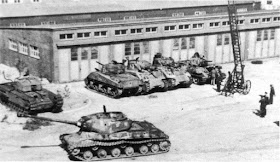 |
| A German tank park composed entirely of captured weapons. This apparently is the Kummersdorf test facility north of Berlin. There appear to be a T-34, a Churchill with wading gear, and some Shermans. This likely was toward the end of the war, circa mid-1944. There were very, very few locations at the time which would have had running German, Soviet, British and US tanks in the same place - and, in fact, there still are very few such places. |
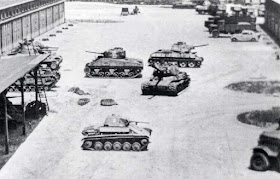 |
| Another view of the Wehrmacht's collection of captured tanks at Kummersdorf. Pictured are maybe an IS-2, an I-70, a Sherman. One thing is for certain, they are not standard panzers. I like the German staff car in the background. |
Some captured weapons were used at testing facilities to determine their strengths and vulnerabilities. Others, the Germans simply used in the field.
 |
| A captured He-111H at an airfield in England sometime in 1945 (colorized). |
The Allies used captured weapons and ships and so forth, too. However, the Germans seemed to practice this sort of opportunism more than the Allies.
 |
| A captured P-51 being used at Rechlin. |
While the weapons were not superior to their own, sometimes something is better than nothing. So, the Germans and others put them to use even if they were patently inferior goods.
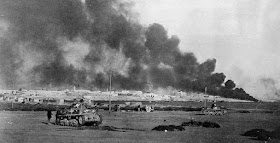 |
| Australian troops watching Tobruk burn, 22 January 1941. Note the captured Italian M13 tank they are using, so indicated by the white kangaroos painted on the side. |
It wasn't just the Axis that did this, either. Everybody used captured equipment if it served a purpose.
 |
| A better closeup up Australian tankers using captured equipment. Italian tanks have never been renowned for their quality, but something is better than nothing. Here, Italian M13/40 and M11/39 tanks have been pressed into Australian service in North Africa, 23 Jan 1941. |
Seeing common weapons of one side used by the other is a bit startling, especially when those weapons have become "famous" or are now considered "classic," but it was quite common.
 |
| An American built M4A3 (76) Sherman medium tank, captured and pressed into service by the German army. German markings and the words Beute Panzer (captured tank) were painted on the tank to avoid friendly fire. The tank was knocked out by a US M36 Jackson tank destroyer. A dead crewmember lies on the front of the tank, probably hit by machine-gun fire while attempting to bail out of the stricken tank. Aschaffenburg, Germany. 1945. |
The Germans had an entire Luftwaffe unit composed of captured Allied equipment, KG 200. It had both bombers and fighters. They had a special name for them, "Beute Panzerkampfwagen" (booty tanks), often just shortened to Beute Panzer.
 |
| P-51B. |
The British had a similar outfit, established during the Battle of Britain. It was No. 1426 (Enemy Aircraft) Flight RAF, nicknamed "the Rafwaffe."
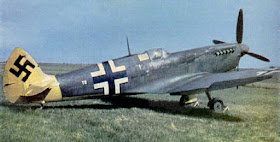 |
| Recognize this one? It's one of the most iconic fighters of the war, but it usually isn't seen in Luftwaffe markings. |
Panzer Abteilung 216 in the Channel Islands and some divisions (eg. 7th SS Freiwillingen Gebirgs Division "Prinz Eugen" in the Balkans) were exclusively equipped with captured equipment.
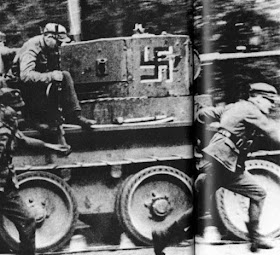 |
| Finnish troops with a captured Russian BT tank during the Winter War. They have painted a bold Swastika emblem on the tank’s turret. The Swastika is an ancient Scandinavian symbol and is not used here to denote any sort of allegiance or kinship to Hitler's Party. In fact, Hitler took the Swastika from the Scandinavians, not the other way around. At this time, the Finns and Germans were not allies - that came later. |
The practice began very early, and the Finns were known to use captured weapons extensively during the 1939-40 Winter War.
 |
| A German soldier in a trench with a captured Soviet PPSH-41 submachine gun on the Eastern Front. Taking small arms off of dead opponents is an extremely common occurrence. |
Some Soviet weaponry was highly prized. One example was the Soviet sniper rifle. While a proud Wehrmacht officer might not admit that it was superior to the best German sniper rifles, a Soviet Mosin-Nagant rifle (officially the 3-line rifle M1891) with a good telescopic lens certainly would do in a pinch (though the best sniper of all time, Simo Häyhä, did not like the scope because he felt it revealed the shooter to the enemy). In fact, the Soviet Mosin-Nagant sniper rifle was so good that it remains in use in various places in the 21st Century. Over 37 million of these sniper rifles have been made (13 million by the end of World War II). The Finns, who could use German or Soviet equipment, chose to use the Mosin-Nagant with some modifications.
 |
| A two-man Scharfschütze (sniper) team. The shooter is using a captured Russian Mosin-Nagant PU rifle. October 1941. |
Soviet submachine guns also were quite handy and reliable. You also could pick them up and throw them down without having to explain to anywhere where your weapon went.
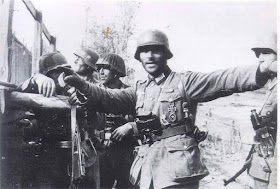 |
| A photographer followed this officer (Hauptmann Friedrich Konrad Winkler) around one day at Stalingrad, taking snaps of him gesturing wildly like this, looking heroically off into the distance and offering other typical propaganda poses. Winkler has broken his Infantry Assault Badge to show that earning it at Stalingrad meant something special. The photographer may not have realized that the grunt to the left is holding a captured Soviet ppsh41 submachine gun. Winkler survived the battle but perished between February 8 and 10, 1943 at POW Camp Beketowka. |
Runs out of ammo? Toss it and pick up another, there were usually dead Soviets around somewhere who didn't need their own any longer.
 |
| Another German using a Soviet submachine gun with the distinctive drum. |
The Allied equipment was used by the Axis for various clandestine operations, particularly in the closing months of the war, but also sometimes just for daily activities.
 |
| Polish 7TP light tank, captured by the German Wehrmacht in the battle for Poland in 1939. The local Panzerwaffe used it for their needs and then sent it west for the defense of France. It was captured by Allied forces in 1944 when this was taken. |
Even Polish equipment from 1939 was put to use for point defense years later. Why not? Beats walking.
Wulf Hound
The first Flying Fortress captured by the Germans was B-17F-27-BO "Wulf Hound" (41-24585) from 360BS 303BG "Hell's Angels". It was damaged by German fighters during a bombing run on 12th of December 1942 and then suffered more hits during its return flight through the Kammhuber Line by a Bf 110 night fighter from NJG 1. The B-17 pilot, Lieutenant Flickinger, elected to land at Leeuwarden airfield in The Netherlands. The bomber was quickly repaired and two days later (after adding German markings) was escorted by two Bf 110s to Rechlin. The evaluation there revealed the strengths and vulnerabilities of the bomber and gave the Luftwaffe engineers ideas for their own designs. Wulf Hound then became the centerpiece at a June 12, 1943, exhibition of captured planes at Lärz airfield. Together with the B-17F, the exhibition included a B-24, P-47D, P-51, P-38, Avro Lancaster, DH Mosquito, Typhoon, and a Spitfire, among other equipment. "Wulf Hound" then returned to Rechlin in July 1943 and was used in trials towing a DFS 230 glider, remaining under evaluation. The bomber ultimately
was transferred to KG 200 in September 1943 and coded A3+AE. It was used in some late-war clandestine missions.
 |
| Wulf Hound. |
The Germans captured about 40 B-17s, and they restored about a dozen to flight capability. They also had an entire class of captured French, Czech, and other nations' weapons, including tanks.
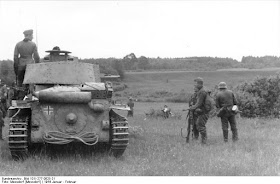 |
| The CKD (Praga) LT vz.38 was renamed Panzerkampfwagen 38(t) in January 1940. Ultimately, 1414 were built, roughly the same number as the Tiger tank. While it was a Czech design, the vast majority of this light tank was produced under German supervision with extensive modifications, including an enlarged turret. Czechoslovakia, of course, was occupied through diplomatic pressure without military force. Thus, for all these reasons, calling this class of weapons "captured" is a bit of a stretch, but the Panzer 38(t) is representative of this murky area. This picture is from the Russian front in early 1944 (Moosdorf, Federal Archive). |
Those weapons stretch the meaning of "captured" because the Germans quickly put the conquered nations to work producing more of those same weapons for them under German names.
 |
| A British Firefly in German service. Note that markings on captured equipment that was re-purposed often were crude, done in the field by men who were not artists. the British soldier is pointing at the shell hole that destroyed the tank. |
 |
| A better view of a German captured M4 Firefly. The Sherman Firefly was a better tank than the standard Sherman due to its 17 pounder main gun, though nobody considers it the equal of a Panther or Tiger. |
One such operation in 1945 landed German agents behind Allied lines in France with suitcases full of counterfeit francs, with the intent of collapsing the French economy through hyperinflation. It failed, and the agents disappeared with the loot (and probably bought a castle or two with it after the war). Another use of Wulf Hound, though,
Operation Carnival a month after that, was an unqualified success.
 |
| One of Luftwaffe boss Hermann Goering's great regrets was that he never had a fleet of four-engined bombers (of course, that was due to his own decisions made in the 1930s). "You can lay out a dance floor in them!" he would yell about the American bombers in exasperation. Goering did, though, acquire one or two. |
The plane undoubtedly was used in other clandestine operations and would have been useful for dispersing compromised people to Spain or other safer havens.
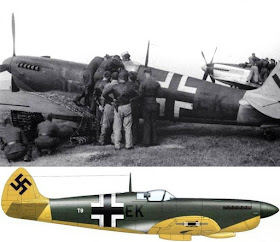 |
| Captured Spitfires in the Luftwaffe. Adolf Galland famously told Hermann Goering in August 1940 that what he needed was a Squadron of Spitfires. Well, eventually he got one. |
Use of American equipment extended far beyond Wulf Hound, of course. The commonly known story of the Battle of the Bulge is that the Germans infiltrated behind US lines using equipment the Germans had captured. This was
Operation Greif, organized by SS boss
Heinrich Himmler. It did not come to much.
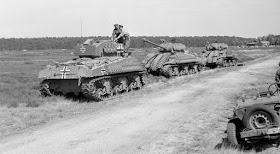 |
| Captured Shermans impressed into Wehrmacht service. |
The Germans did use their captured equipment during that operation. However, much of the equipment used in Operation Greif was German weaponry with the markings simply switched to American markings. It didn't really fool anyone but did create an enduring legend.
 |
| Certainly, you recognized this one. Hover over the picture if you don't recognize it. |
Captured weapons may not swing the tide of war, but they can come in handy for ordinary grunts who would rather ride than walk, even if it is in a captured British lorry.
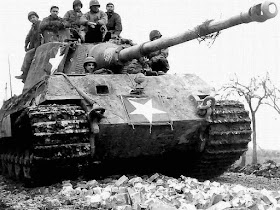 |
| US troops drive a King Tiger German tank that has already obtained its US Army star. |
The US forces also, of course, captured all sorts of German equipment, including their very best. As the best stocked of all the armies, though, US forces tended not to use its captured equipment very much in combat. Such captured equipment was quickly shipped back to the US for testing and evaluation.
 |
| T-34 in German service. The markings on the hatch would be to keep any Panzerknackers like Hans-Ulrich Rudel from bombing them. |
Intelligence thus gathered guided weapons development in the immediate postwar years.
 |
| Russian soldiers with a captured German Nebelwerfer 41 rocket launcher. |
The Germans were quick to use captured Soviet tanks. While nobody could admit it, Soviet armor often was at the very least the equal of German tanks, and quite often superior.
 |
| German soldiers clean and services captured Russian sub-machine guns highly sought after for their ruggedness and setting to fire single shots, 1942. |
Legend has it that at one Time, elite SS Panzer Division Das Reich had more than 200 T34s in their inventory. Better to use a Soviet tank than no tank. Spare parts could be had on the battlefield... assuming you kept advancing.
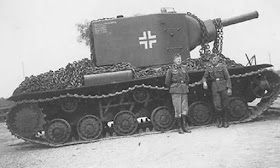 |
| KV Tank in the Wehrmacht. |
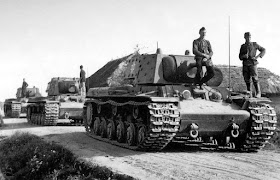 |
| A column of KV-1Es Soviet tanks captured by German and reused in the Wehrmacht. |
At one point, the Germans even considered simply copying the T-34, but German factories were not set up with the right machining to replicate it. Besides, it would have looked bad.
 |
| T-34s used in the Wehrmacht. |
Still, the Germans needed a quality medium tank. So, instead, they developed what many consider the finest tank of the entire war, the
Panther. It was not perfect - it had transmissions issues and was a bit fancier than the basic tank (in larger numbers) the grunts really needed - but it was a classic, well-thought-out product that tended to get the job done when you needed it.
 |
| This is a Russian T-34 with German markings. The Germans used many enemy tanks during the war. A common captured weapon was the British Bren gun carrier, to which the Germans attached rocket launchers and used in dedicated squads against the Soviets. |
During Operation Barbarossa, the Germans captured immense stockpiles of Soviet equipment. They captured so many Soviet 76.2mm anti-tank guns that they designed an entire weapons system around them, the Marder tank destroyer. Initially, the Germans just bolted the captured guns to the top of other captured equipment, the 38(t) Czech tank, and sometimes onto captured French Lorraine tanks. They also were a good way to recycle obsolete Panzer IIs. Later Marders had new undercarriages. While not the world's greatest weapon (they had very weak armor), Marders were reliable and useful in defensive situations outside of cities (open on the top, snipers could fire down on exposed crews). They were sort of the "poor man's StuG." Marders went into numerous units, including some of the best (SS Divisions and the Hermann Goering). About 350 Marder Ausf. Ms remained in combat during the last days of the Reich.
 |
| SdKfz 138-139 Marder III incorporating a Russian 7.62cm anti-tank gun abandoned in North Africa, 1943. |
Naturally, the Soviets used German equipment as well. One could say that using captured equipment is a compliment to the opposing army, but in reality, it is more simply a way for ordinary soldiers to improve their firepower and perhaps survivability with whatever is lying around.
 |
| A Sherman in Wehrmacht markings on the Russian Front. |
If all you have is a rifle and you find an enemy submachine gun with ammo in the field, using it makes you a little more fearsome regardless of whether your own army's weapons have higher quality ratings. Naturally, captured weapons also give you a little more credibility if you are trying to infiltrate enemy lines and you are posing as something that you are not.
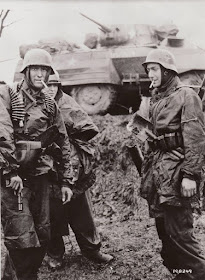 |
| German soldiers smoke captured American cigarettes in front of a U.S. Army armored car on December 17, 1944. |
Sometimes, a deprived army isn't actually interested too much in using captured equipment. Rather, they have enough weapons and are more in need of more mundane enemy goods. Captured weapons always look good for the photographers, though.
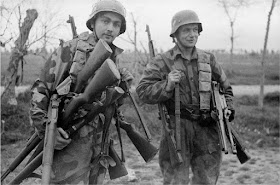 |
| Wehrmacht soldiers posing with captured American weapons, 1944. |
Sometimes, capturing enemy stocks can become an objective in and of itself. During the Ardennes Offensive in December 1944, a key to the German plan was to use elite forces to break open the American lines so fast that large quantities of gasoline and other scarce supplies could be captured to fuel the advance further. Much was captured, but not nearly enough to supply the entire Wehrmacht during its dying days.
 |
| Balikpapan, Borneo. July 1945. Australian Jack Keanne of Stanthorpe, Qld, studies the hills surrounding Balikpapan, through captured giant field glasses which are resting on a Japanese wooden crate. |
The use of captured weapons was much reduced in the Pacific Theater of Operations because of the nature of the island-hopping campaigns. If you were going to invade an island, you wouldn't need to bring along any captured equipment, and most of the island battles didn't last too long (with some notable exceptions). Japanese tanks were obsolete and few and far between, but now and then more mundane enemy equipment came in handy.
Things are not Always What They Seem
 |
| A Dornier Do-17 in British service in Egypt. |
Finally, you have to be careful when assuming some enemy weapons were "captured." To illustrate the point, the Dornier Do 17 was a well known Luftwaffe plane, so seeing one in British colors naturally leads to the impression that the British must have captured it and put it to use. However, pre-war weapons sales often went to later adversaries. The above German Do-17 in British markings, for instance, is not a captured aircraft. Instead, it is a former Royal Yugoslav Air Force Do 17K escaped from that country after the Kingdom of Yugoslav’s fall in April 1941.
Between 14 and 15 April 1941, seven Yugoslav Do 17Ks flew to Nikšić airport and took part in the evacuation of King Petar II and members of the Yugoslav government to Greece as well as of the Yugoslav gold reserves. The planes, together with the S.79K used for the King’s escape, landed at Paramythia, a Greek airfield not far from the border with Albania which at this time was still the base of RAF No 211 Squadron. Five of the Dorniers were soon destroyed by an Italian Air Force raid. The two survivors escaped to Egypt, just before the fall of the base into Axis hands, together with the S.79K with the young King (18 years) on board. In Egypt, both of the German-built planes, previously in the Royal Yugoslav Air Force’s 209 Eskadrila, were absorbed by the RAF and allocated codes AX707 and AX706. Their life in the RAF ranks was extremely brief: both were destroyed by an enemy air raid on 27 August 1941, an unusual instance of the Luftwaffe being happy to destroy German-built aircraft.
Partisans
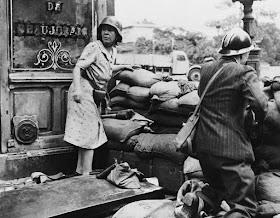 |
| A French man and woman fight with captured German weapons as both civilians and members of the French Forces of the Interior took the fight to the Germans. This is Paris in August of 1944, just prior to the surrender of German forces and the Liberation of Paris on August 25 |
Captured weaponry is handy for regular army units, but it is absolutely critical for partisans. With no other source of weaponry, a submachine gun grabbed from a dead soldier could turn a hanger-on into a useful fighter.
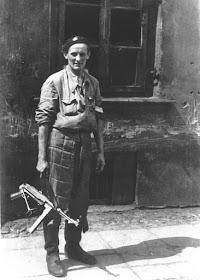 |
| Partisans all across Europe wound up using captured German weapons. Here, Polish resistance fighter Roman Marchel posing with a captured MP 40 submachine gun during the Warsaw Uprising, Ciepla Street, Warsaw, Poland, 20 Aug 1944. |
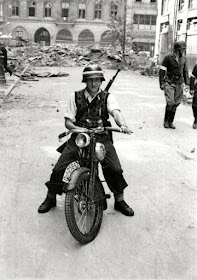 |
| Another partisan in Warsaw using German equipment. |
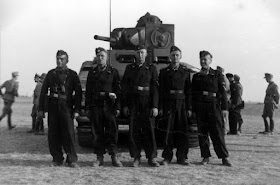 |
| The 7th SS Volunteer Division “Prinz Eugen” in front of a Pz.Kpfw. B2 740 (f) (German designation of captured French tank Char B1). French tanks were quite good, many much better than Panzer IIIs which formed the backbone of the Panzerwaffe early in the war. |
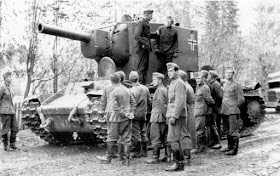 |
| Germans using a KV tank. They were slow, but heavily armed and with a huge gun. |
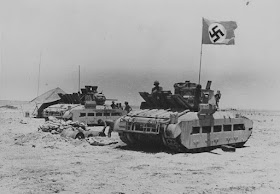 |
| Captured Matildas in the Western Desert. Note the "big ass" flag? That wasn't for show. The Luftwaffe was very active in North Africa and would love to have knocked those tanks out. German artillery also needed to be made aware. In fact, driving a captured British tank in North Africa was quite dangerous. |
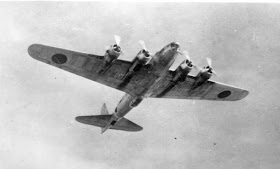 |
| The Japanese captured this B-17D in the Philippines and put it in their markings. They flew it to Japan for evaluation. |
2020




























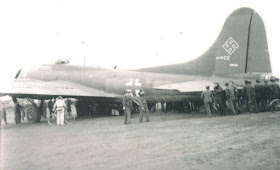
















I seriously doubt that the last photography is authentic, it looks very much like a movie still (very sharp, very well lit scenery, no stains on the clothes and no scratches on the weapons etc.). And why should the dead (or dying) German soldier hold his Sturmgewehr 44 at the barrel? No, this picture is definitively a staged one and as such no source of any historical value...
ReplyDeleteThat's a shame, that's a great shot. Unfortunately, these kinds of fakes are more and more common, especially staged photos of German atrocities and such which are done to "make a point" about this, that and the other thing. Anyway, thanks for the ID, I think you're right and I pulled it.
DeleteThe Wehrmacht could not have pulled off its successes in Poland, the Low Countries, France, and even in Russia ("Barbarossa" period) w/o the considerable amount of Czech 35(t) and 38(t) tanks to augment their Panzerwaffe. The Czech 38(t) was developed into several iterations of self-propelled guns and howitzers, which themselves often proved to be effective tank killers, and finally ended up in the Jagpanzer Hetzer...which was still used as the model G13 by the Swiss until 1974!
ReplyDeleteYes, the Germans did consider copying the T-34, but it wasn't parochialism that persuaded them not to proceed with a Damlier-Benz design which was fairly much a copy (there were prototypes that had a diesel and another a gasoline engine). The T-34 used a two-man turret which Guderian ruled as unacceptable, the DB design couldn't be modified to accept a three-man turret (unlike what was done later with the T-34 resulting in the T-34/85), let alone they were unimpressed with the poor reliability and service life of the T-34's V2 diesel engine and it's clunky gearbox (had to be shifted on the go with a hammer). The MAN design met the German requirements far better, though as the Panther it was a far cry from the original VK30.02 (45 tons versus 30 tons) and suffered from 'design creep'. The Germans suffered from many of the technical and managerial issues that plagued the Soviets with their T-34 designs...they were breaking new ground and didn't have time to refine the designs, they had to put into mass production what they had.
The Soviets liked the Pz III and Pz IV tanks and their StuG and JagPz variants, and even produced spare parts for what they captured (like at Stalingrad). They even modified some PzIIIs with the older L/42 5 cm gun (it was rather puny) into a self-propelled gun with their home-grown 76mm gun (which the Germans themselves used a great deal of captured examples and even developed a line of ordnance for) as the SU-76i. As for the Panthers and Tigers, they derided their 'poor' reliability but that didn't stop them from translating the humorous tank manuals ("Pantherfibel' und "Tigerfibel") into Russian. The Soviets also used whatever was sent to them by the UK and USA under Lend-Lease, they especially liked the diesel-engined M4 Shermans (Nicknamed "EmCha" which is how "M4" is pronounced in Russian). The Soviet M4s were actually prioritized for their several "Guards Armored' divisions, being considered a better tank than their own T-34, though to say so publicly wasn't a formula for a long life under "Uncle Joe" Stalin.
It's interesting that Germans and Russians had a passion for using each others small arms. The Germans even produced the ammo for the "Pe-Pe-Shaw" as it was so popular with the troops. However, contrary to what many think, the later AK-47 is NOT a direct copy of the StG 44 (named an "assault rifle' by Hitler himself) though Mikhail Kalashnikov was inspired by many of the German assault rifle's features. Contrary to popular notion, a cut-down battle rifle using an intermediate cartridge was NOT a new idea, a Russian named Federov had devised one in 1912 using the Japanese 6.5mm Arisaka cartridge. The Russians were very impressed by what they saw in the StG44, hence they curtailed production of the SKS carbine (which uses the same round as the AK-47) and went with Kalashnikov's new toy.